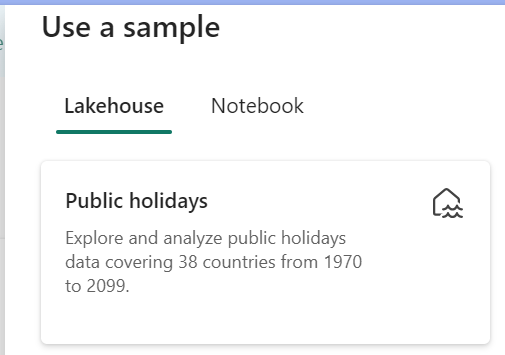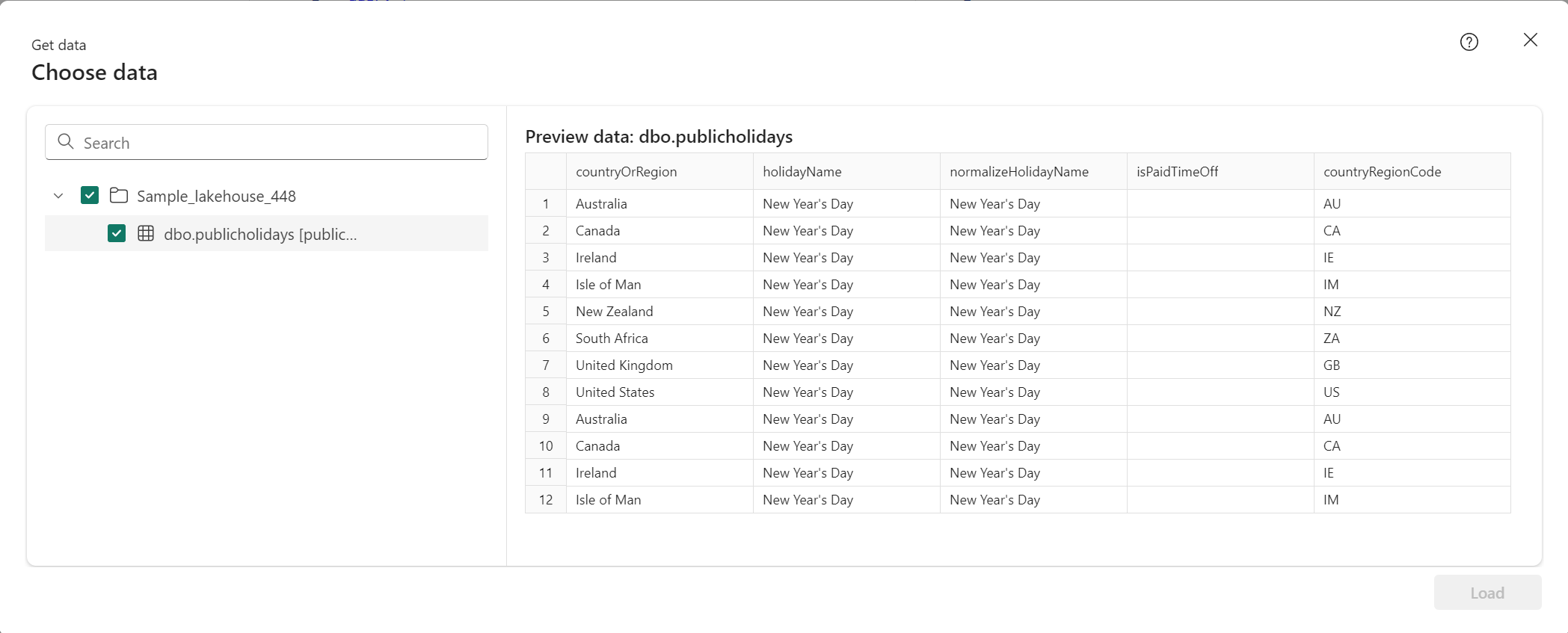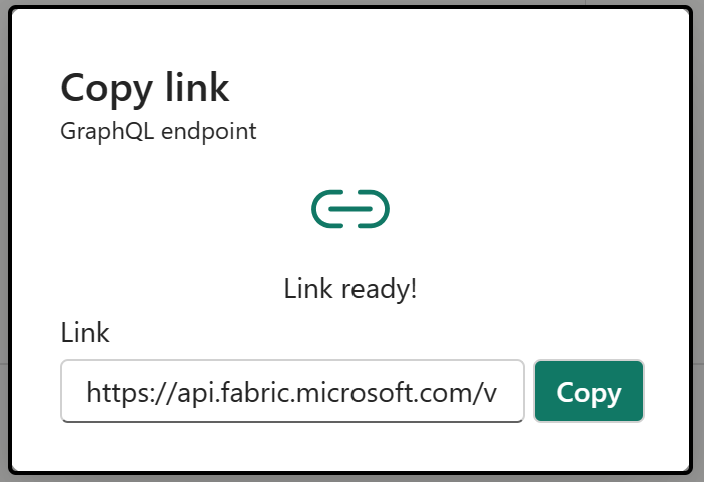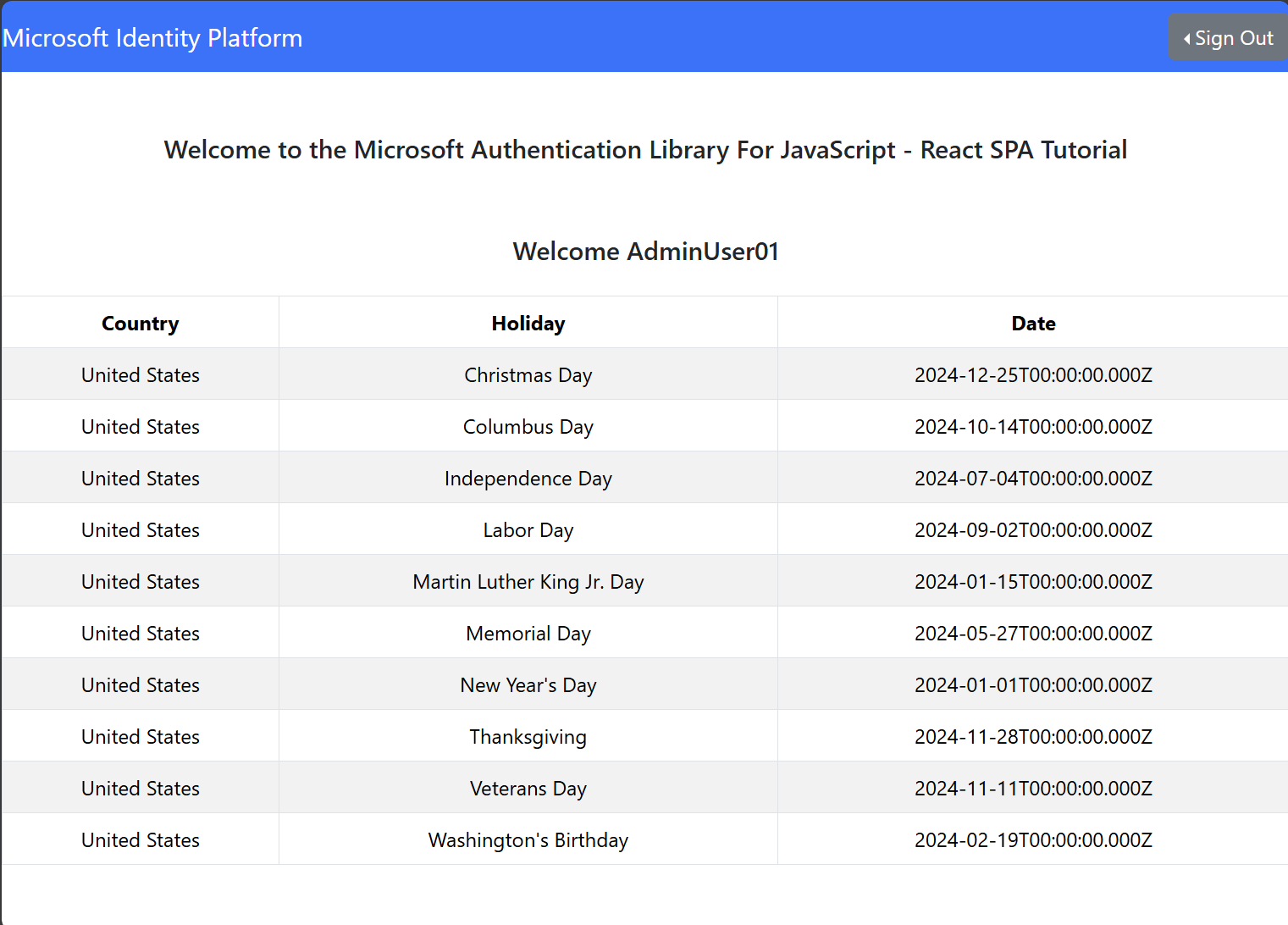若要將應用程式連線到 GraphQL 的 API,您需要三個重要詳細資料: 用戶端識別碼、 租用戶識別碼,以及 Fabric 中的 GraphQL 端點位址 。 以下各節說明如何建立和擷取所需的詳細資訊,以及如何使用範例 React 應用程式存取您的 API。
其他語言
本教學課程說明如何將 React 範例應用程式連線到適用於 GraphQL 的 Fabric API。 您可以在 Microsoft Fabric 範例 GitHub 存放庫中找到 C#、Python 和其他語言範例。
必要條件
連線應用程式之前,請確定您在 Fabric 中有 GraphQL 的 API。 如需詳細資訊,請參閱在 Fabric 中建立適用於 GraphQL 的 API 並新增資料。
適用於 GraphQL 的 API 需要應用程式使用 Microsoft Entra 進行驗證。 註冊並設定您的應用程式,以針對 Fabric 執行 API 呼叫。 如需詳細資訊,請參閱在 Azure 中建立 Microsoft Entra 應用程式。
呼叫 API 的已驗證憑證(使用者主體、服務主體或受管識別)需要具有 GraphQL API 的執行權限(在新增直接存取權限時選擇 "執行查詢和變動" 選項)。 如果使用單一登入 (SSO) 作為 API 中的連線選項,請確定認證在所選資料來源中具有讀取或寫入許可權。 如需詳細資訊,請參閱 連線至資料源並建置架構。
建立 Microsoft Entra 應用程式
下列步驟說明如何在 Microsoft Entra 中設定 ReactJS 應用程式的支援。
Microsoft Entra 應用程式 (用戶端) 識別碼 和 目錄 (租用戶識別碼) 值會出現在 [摘要] 方塊中。 記錄這些值,因為稍後需要這些值。
在 [管理] 列表中,選取 [API 許可權],然後選取 [新增許可權]。
新增 PowerBI 服務、選取 [委派的許可權],然後選取 [GraphQLApi.Execute.All ] 許可權。 確認不需要系統管理員同意。
返回 管理 清單,選取 驗證 新增>平台>單頁應用程式。
針對本機開發目的,請在 [重新導向 URI
http://localhost:3000新增 ,並確認應用程式已針對授權碼流程啟用,且具有適用於程式代碼交換的證明金鑰 (PKCE) 。 選取 [設定] 按鈕來儲存變更。 如果應用程式遇到與跨來源要求相關的錯誤,請在上一個步驟中使用相同的重新導向 URI 新增 行動和桌面應用程式 平台。回到 [驗證],向下捲動至 [進階設定],然後在 [允許公用用戶端流程] 下,選取 [[是][啟用下列行動和桌面流程]。
設定應用程式存取的範例 GraphQL API
在此範例中,我們會建立 GraphQL API,將範例 Lakehouse 資料公開給用戶端。
從 [網狀架構入口網站] 首頁,從工作負載清單中選取 [資料工程師]。
在 [資料工程] 體驗中,選取 [使用範例],然後在 Lakehouse 底下,選取 [國定假日] ,以自動建立包含國定假日資料的新 Lakehouse。
請遵循 建立 GraphQL 的 API 中的步驟來建立新的 GraphQL API,然後選取您建立的 Lakehouse。 新增公共假期表格,以便用戶端可以存取此資料。
使用下列範例查詢,在 API 編輯器中測試 GraphQL API。 這與 React 用戶端應用程式中使用的查詢相同:
query { publicholidays (filter: {countryRegionCode: {eq:"US"}, date: {gte: "2024-01-01T00:00:00.000Z", lte: "2024-12-31T00:00:00.000Z"}}) { items { countryOrRegion holidayName date } } }選取 API 項目工具列上的 [複製端點]。
在 [複製連結] 畫面中,選取 [複製]。
使用先前記錄的 Microsoft Entra 應用程式中的 用戶端識別碼 和 租用戶識別碼 ,並複製端點 URI,因為稍後需要它。
設定 React 應用程式以存取公共假日 API
備註
如果您想要略過下列手動步驟,您可以使用完整的應用程式複製 GitHub 存放庫 。 請遵循步驟 3,將 GraphQL 端點和從 Microsoft Entra 擷取的特定詳細數據新增至檔案 authConfig.js,透過 npm install 安裝相依性,並跳至步驟 9 以繼續測試應用程式執行。
使用現有的 React 應用程式作為起點。 請遵循教學課程中的步驟建立 React 單頁應用程式,並準備進行驗證 ,以建立已設定 Microsoft Entra 驗證的 React 專案,包括新增至專案結構的必要檔案和資料夾。 變更三個檔案,以調整應用程式以適應 GraphQL 使用案例。
在
src資料夾中,開啟authConfig.js檔案,並將檔案內容替換為以下程式碼片段:/* * Copyright (c) Microsoft Corporation. All rights reserved. * Licensed under the MIT License. */ import { LogLevel } from "@azure/msal-browser"; /** * Configuration object to be passed to MSAL instance on creation. * For a full list of MSAL.js configuration parameters, visit: * https://github.com/AzureAD/microsoft-authentication-library-for-js/blob/dev/lib/msal-browser/docs/configuration.md */ export const graphqlConfig = { graphqlEndpoint: "`Enter_the_GraphQL_Endpoint_Here" }; export const msalConfig = { auth: { clientId: "Enter_the_Application_Id_Here", authority: "https://login.microsoftonline.com/Enter_the_Tenant_Info_Here", redirectUri: "http://localhost:3000", }, cache: { cacheLocation: "sessionStorage", // This configures where your cache will be stored storeAuthStateInCookie: false, // Set this to "true" if you are having issues on IE11 or Edge }, system: { loggerOptions: { loggerCallback: (level, message, containsPii) => { if (containsPii) { return; } switch (level) { case LogLevel.Error: console.error(message); return; case LogLevel.Info: console.info(message); return; case LogLevel.Verbose: console.debug(message); return; case LogLevel.Warning: console.warn(message); return; default: return; } } } } }; /** * Scopes you add here will be prompted for user consent during sign-in. * By default, MSAL.js will add OIDC scopes (openid, profile, email) to any login request. * For more information about OIDC scopes, visit: * [OpenID Connect scopes](/azure/active-directory/develop/v2-permissions-and-consent#openid-connect-scopes) */ export const loginRequest = { scopes: ["https://analysis.windows.net/powerbi/api/GraphQLApi.Execute.All"] }; /** * Add here the scopes to request when obtaining an access token for MS Graph API. For more information, see: * https://github.com/AzureAD/microsoft-authentication-library-for-js/blob/dev/lib/msal-browser/docs/resources-and-scopes.md */ export const graphConfig = { graphMeEndpoint: "https://graph.microsoft.com/v1.0/me", };如您在上述程式碼中所見,請務必使用正確的範圍來存取應用程式。 在我們的案例中
https://analysis.windows.net/powerbi/api/GraphQLApi.Execute.All。將下列值取代為來自 Microsoft Entra 系統管理中心的值。
clientId - 應用程式的識別碼,也稱為用戶端。 將
Enter_the_Application_Id_Here更換為先前從已註冊 Microsoft Entra 應用程式概觀頁面記錄的 Application(用戶端)識別碼 值。authority - 這由兩部分組成:
執行個體是雲端提供者的端點。 在國家雲端中檢查不同的可用端點。
租用戶識別碼是註冊應用程式的租用戶識別碼。 將
Enter_the_Tenant_Info_Here替換為先前從已註冊應用程式的概觀頁面記錄下來的 目錄(租戶)識別碼 值。
graphQLEndpoint - 適用於 GraphQL 端點的 Fabric API。 使用稍早記錄的 GraphQL API 端點取代
Enter_the_GraphQL_Endpoint_Here。
儲存檔案。
在相同的
src資料夾中,開啟App.js檔案,並以下列代碼段取代檔案的內容:import React, { useState } from 'react'; import { PageLayout } from './components/PageLayout'; import { loginRequest, graphqlConfig } from './authConfig'; import { ProfileData } from './components/ProfileData'; import { AuthenticatedTemplate, UnauthenticatedTemplate, useMsal } from '@azure/msal-react'; import './App.css'; import Button from 'react-bootstrap/Button'; import Spinner from 'react-bootstrap/Spinner'; /** * Renders information about the signed-in user or a button to retrieve data about the user */ const ProfileContent = () => { const { instance, accounts } = useMsal(); const [graphqlData, setGraphqlData] = useState(null); const [display, setDisplay] = useState(false); function RequestGraphQL() { // Silently acquires an access token which is then attached to a request for GraphQL data instance .acquireTokenSilent({ ...loginRequest, account: accounts[0], }) .then((response) => { callGraphQL(response.accessToken).then((response) => setGraphqlData(response)); }); } async function callGraphQL(accessToken) { setDisplay(true); const query = `query { publicholidays (filter: {countryRegionCode: {eq:"US"}, date: {gte: "2024-01-01T00:00:00.000Z", lte: "2024-12-31T00:00:00.000Z"}}) { items { countryOrRegion holidayName date } } }`; fetch(graphqlConfig.graphqlEndpoint, { method: 'POST', headers: { 'Content-Type': 'application/json', 'Authorization': `Bearer ${accessToken}`, }, body: JSON.stringify({ query: query }) }) .then((res) => res.json()) .then((result) => setGraphqlData(result)); } return ( <> <h5 className="card-title">Welcome {accounts[0].name}</h5> <br/> {graphqlData ? ( <ProfileData graphqlData={graphqlData} /> ) : ( <Button variant="primary" onClick={RequestGraphQL}> Query Fabric API for GraphQL Data {display ? ( <Spinner as="span" animation="border" size="sm" role="status" aria-hidden="true" /> ) : null} </Button> )} </> ); }; /** * If a user is authenticated the ProfileContent component above is rendered. Otherwise a message indicating a user is not authenticated is rendered. */ const MainContent = () => { return ( <div className="App"> <AuthenticatedTemplate> <ProfileContent /> </AuthenticatedTemplate> <UnauthenticatedTemplate> <h5> <center> Please sign-in to see your profile information. </center> </h5> </UnauthenticatedTemplate> </div> ); }; export default function App() { return ( <PageLayout> <center> <MainContent /> </center> </PageLayout> ); }儲存檔案。
最後,在
src/components資料夾下,開啟ProfileData.jsx檔案,並以下列代碼段取代檔案的內容:import React from "react"; import ListGroup from 'react-bootstrap/ListGroup'; import Table from 'react-bootstrap/Table'; /** * Renders information about the user obtained from MS Graph * @param props */ export const ProfileData = (props) => { const holidays = props.graphqlData.data.publicholidays.items; return ( <Table striped bordered hover responsive> <thead> <tr> <th>CountryOrRegion</th> <th>Holiday</th> <th>Date</th> </tr> </thead> <tbody> {holidays.map((item,i) => ( <tr key={i}> <td>{item.countryOrRegion}</td> <td>{item.holidayName}</td> <td>{item.date}</td> </tr> ))} </tbody> </Table> )};儲存所有檔案變更。
在終端應用程式中,前往 React 專案的根資料夾並執行命令
npm start以在本地測試應用程式。當應用程式在瀏覽器中載入
http://localhost:3000時,請遵循教學指引最後一部分的步驟,從應用程式中呼叫 API 。登入之後,選取 [查詢 Fabric API for GraphQL 資料] 按鈕。
對 Fabric 中 GraphQL API 的成功驗證要求會將 GraphQL 查詢中的資料傳回至 React 用戶端應用程式中的 Lakehouse:





